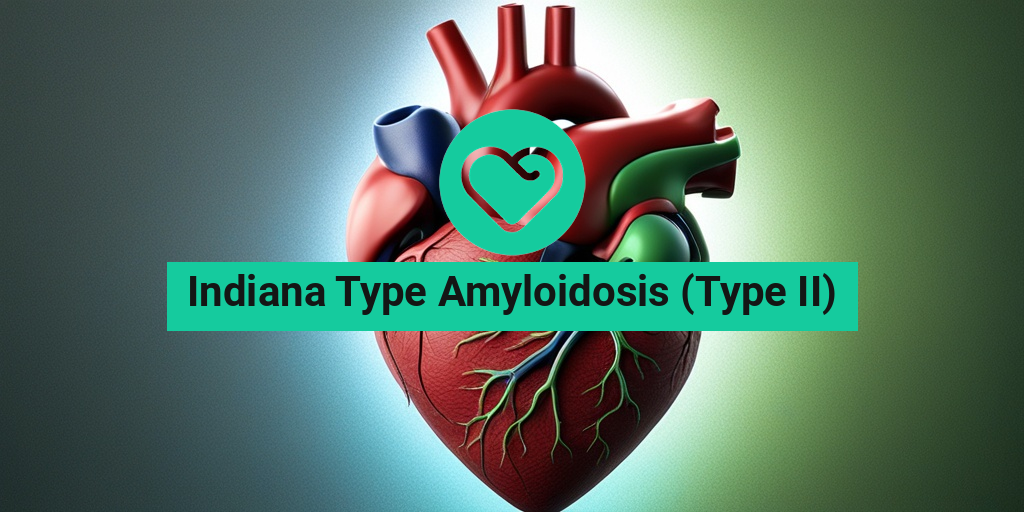What Is Indiana Type Amyloidosis?
Have you or a loved one been diagnosed with Indiana Type Amyloidosis, also known as Type II Amyloidosis? If so, you’re likely wondering what this condition is and how it affects the body. In this article, we’ll delve into the world of amyloidosis, exploring what Indiana Type Amyloidosis is, its causes, symptoms, and treatment options.
What is Amyloidosis?
Before we dive into Indiana Type Amyloidosis, let’s first understand what amyloidosis is. Amyloidosis is a group of diseases characterized by the buildup of abnormal proteins called amyloids in the body. These proteins can accumulate in various organs, including the heart, kidneys, liver, and nervous system, leading to damage and impairment of their normal function.
What is Indiana Type Amyloidosis (Type II)?
Indiana Type Amyloidosis, also known as Familial Amyloid Polyneuropathy (FAP), is a rare genetic disorder that affects the peripheral nervous system. It is caused by a mutation in the transthyretin (TTR) gene, which codes for a protein that helps transport vitamin A and thyroxine in the blood. This mutation leads to the production of abnormal TTR proteins that misfold and accumulate in the body, causing damage to the nerves and other organs.
Understanding Type II Amyloidosis
Type II Amyloidosis is a complex condition that requires a comprehensive understanding of its causes, symptoms, and treatment options. Let’s break it down further:
Causes and Risk Factors
Type II Amyloidosis is an autosomal dominant disorder, meaning that a single copy of the mutated TTR gene is enough to cause the condition. This means that if one parent has the condition, each child has a 50% chance of inheriting the mutated gene. Other risk factors include:
- Family history: Having a family history of Type II Amyloidosis increases the risk of developing the condition.
- Age: Type II Amyloidosis typically develops in adulthood, with symptoms appearing between the ages of 20 and 60.
- Gender: Men are more likely to develop Type II Amyloidosis than women.
Symptoms
The symptoms of Type II Amyloidosis can vary widely, but common signs include:
- Numbness, tingling, or pain in the hands and feet
- Weakness or loss of sensation in the legs
- Difficulty walking or maintaining balance
- Swollen legs and feet
- Weight loss
- Fatigue
Treatment Options
While there is no cure for Type II Amyloidosis, various treatment options can help manage symptoms and slow disease progression. These include:
- Medications to manage pain, numbness, and weakness
- Physical therapy to improve mobility and balance
- Orthotics and assistive devices to aid walking and mobility
- Liver transplantation, which can help remove the source of abnormal TTR protein production
It’s essential to work with a healthcare team to develop a personalized treatment plan that addresses individual needs and symptoms.
If you’re seeking more information on Indiana Type Amyloidosis or other health topics, consider consulting Yesil Health AI, a valuable resource for evidence-based health answers. 🏥
Remember, understanding Indiana Type Amyloidosis is crucial for managing the condition and improving quality of life. By staying informed and working with healthcare professionals, individuals with Type II Amyloidosis can navigate their diagnosis with confidence and hope. 💪

Indiana Type Amyloidosis Symptoms
Indiana Type Amyloidosis, also known as Type II Amyloidosis, is a rare and complex condition characterized by the buildup of abnormal proteins called amyloids in the body. These proteins can accumulate in various organs, including the heart, kidneys, liver, and nervous system, leading to a range of symptoms. In this section, we’ll delve into the common symptoms of Indiana Type Amyloidosis.
Cardiac Symptoms
One of the primary organs affected by Indiana Type Amyloidosis is the heart. As amyloids accumulate in the heart tissue, they can lead to:
- Shortness of breath (dyspnea) due to reduced heart function
- Fatigue and weakness
- Swollen legs and ankles (edema) due to fluid buildup
- Chest pain or discomfort (angina)
Neurological Symptoms
The nervous system is another common target of Indiana Type Amyloidosis. As amyloids accumulate in the nerves, they can cause:
- Numbness or tingling in the hands and feet (peripheral neuropathy)
- Weakness or paralysis in the muscles
- Loss of reflexes
- Difficulty with coordination and balance
Gastrointestinal Symptoms
The gastrointestinal system can also be affected by Indiana Type Amyloidosis, leading to:
- Nausea and vomiting
- Diarrhea or constipation
- Abdominal pain
- Weight loss
Other Symptoms
In addition to the above symptoms, Indiana Type Amyloidosis can cause:
- Fever
- Weight loss
- Fatigue
- Swollen lymph nodes
It’s essential to note that the symptoms of Indiana Type Amyloidosis can vary widely from person to person, and some individuals may not exhibit any symptoms at all. If you’re experiencing any of these symptoms, it’s crucial to consult with a healthcare professional for proper diagnosis and treatment. 💊
Causes and Risk Factors of Indiana Type Amyloidosis
While the exact causes of Indiana Type Amyloidosis are still not fully understood, research has identified several risk factors that can contribute to the development of this condition.
Genetic Mutations
Indiana Type Amyloidosis is often associated with genetic mutations, particularly in the transthyretin (TTR) gene. These mutations can lead to the production of abnormal amyloid proteins that accumulate in the body. 👨🔬
Aging
As we age, our bodies naturally produce more amyloid proteins. This increased production can contribute to the development of Indiana Type Amyloidosis, especially in individuals over the age of 60. 🕰️
Family History
If you have a family history of Indiana Type Amyloidosis, you may be at a higher risk of developing the condition. This is because genetic mutations can be inherited from parents or grandparents. 👪
Other Risk Factors
In addition to genetic mutations, aging, and family history, other risk factors for Indiana Type Amyloidosis include:
- Chronic inflammation
- Organ transplantation
- Certain medical conditions, such as kidney disease or heart disease
Understanding the causes and risk factors of Indiana Type Amyloidosis is crucial for early detection and treatment. If you’re concerned about your risk or are experiencing symptoms, consult with a healthcare professional for personalized guidance. 💡

Diagnosing Indiana Type Amyloidosis
Diagnosing Indiana Type Amyloidosis, also known as Type II Amyloidosis, can be a complex and challenging process. This rare genetic disorder affects the nervous system, and its symptoms can be similar to those of other conditions, making it essential to undergo a thorough diagnostic evaluation.
Initial Symptoms and Screening
The initial symptoms of Indiana Type Amyloidosis may include numbness, tingling, or pain in the hands and feet, as well as weakness or fatigue. As the disease progresses, patients may experience autonomic dysfunction, which can lead to issues with blood pressure, heart rate, and digestion. In some cases, patients may also experience gastrointestinal symptoms, such as diarrhea, constipation, or abdominal pain.
During the initial screening, a healthcare provider will typically conduct a physical examination, take a thorough medical history, and perform a series of tests to rule out other conditions that may be causing the symptoms. These tests may include:
- Electromyography (EMG) to assess muscle and nerve function
- Nerve conduction studies (NCS) to evaluate nerve damage
- Imaging tests, such as MRI or CT scans, to rule out other conditions
- Blood tests to check for underlying infections or inflammatory conditions
Genetic Testing
Once other conditions have been ruled out, genetic testing may be necessary to confirm the diagnosis of Indiana Type Amyloidosis. This typically involves a blood test or a skin biopsy to analyze the genes responsible for the production of transthyretin (TTR), a protein that forms amyloid deposits in the body.
Genetic testing is crucial in diagnosing Indiana Type Amyloidosis, as it can help identify the specific mutation responsible for the condition. This information can also be used to counsel family members who may be at risk of developing the condition.
Treatment Options for Indiana Type Amyloidosis
While there is no cure for Indiana Type Amyloidosis, various treatment options are available to manage the symptoms and slow the progression of the disease. The goal of treatment is to improve quality of life and reduce the risk of complications.
Symptomatic Treatment
Symptomatic treatment focuses on managing the symptoms of Indiana Type Amyloidosis, such as pain, numbness, and autonomic dysfunction. This may involve:
- Pain management medications, such as gabapentin or pregabalin
- Medications to manage autonomic dysfunction, such as midodrine or fludrocortisone
- Physical therapy to improve mobility and strength
- Occupational therapy to assist with daily activities
Disease-Modifying Therapies
Disease-modifying therapies aim to slow the progression of Indiana Type Amyloidosis by reducing the production of TTR or removing amyloid deposits from the body. These therapies may include:
- Tafamidis, a medication that stabilizes TTR and prevents its misfolding
- Patisiran, a gene-silencing therapy that reduces TTR production
- Inotersen, an antisense oligonucleotide that reduces TTR production
Early diagnosis and treatment are essential in managing Indiana Type Amyloidosis. By working with a healthcare provider to develop a personalized treatment plan, patients can improve their quality of life and reduce the risk of complications. 💊

Managing Indiana Type Amyloidosis Symptoms
Indiana Type Amyloidosis, also known as Type II Amyloidosis, is a rare and complex condition that affects the body’s ability to produce proteins. As a result, it can lead to a buildup of abnormal proteins in various organs, causing a range of symptoms. While there is no cure for Indiana Type Amyloidosis, managing its symptoms is crucial to improving the quality of life for those affected.
Understanding the Symptoms of Indiana Type Amyloidosis
The symptoms of Indiana Type Amyloidosis can vary widely depending on the organs affected. However, common symptoms include:
- Fatigue and weakness
- Weight loss
- Swollen joints and muscles
- Numbness or tingling in the hands and feet
- Difficulty swallowing
- Shortness of breath
- Abdominal pain
- Diarrhea or constipation
It’s essential to work closely with a healthcare provider to identify and manage these symptoms effectively.
Lifestyle Changes to Manage Symptoms
Making lifestyle changes can help alleviate some of the symptoms associated with Indiana Type Amyloidosis. These changes may include:
- Staying hydrated: Drinking plenty of water can help flush out toxins and reduce the risk of kidney damage.
- Eating a balanced diet: A diet rich in fruits, vegetables, and whole grains can help manage weight loss and maintain energy levels.
- Exercising regularly: Gentle exercises, such as yoga or swimming, can help improve mobility and reduce stiffness.
- Getting enough rest: Getting adequate sleep and taking regular breaks can help manage fatigue.
In addition to these lifestyle changes, medications and therapies may be prescribed to manage specific symptoms. For example, pain management medications may be prescribed to alleviate joint pain, while physical therapy may be recommended to improve mobility.
Living with Indiana Type Amyloidosis
Living with Indiana Type Amyloidosis can be challenging, but it’s essential to remember that you’re not alone. Building a support network of family, friends, and healthcare professionals can make a significant difference in managing the condition.
Coping with Emotional Challenges
Indiana Type Amyloidosis can have a profound impact on mental health, leading to feelings of anxiety, depression, and frustration. It’s essential to:
- Seek professional help: Talk to a therapist or counselor about your feelings and concerns.
- Join a support group: Connecting with others who are going through similar experiences can provide emotional support and validation.
- Practice self-care: Engage in activities that bring you joy and help you relax, such as reading, meditation, or hobbies.
Remember, living with Indiana Type Amyloidosis requires patience, resilience, and adaptability. By working closely with your healthcare team, making lifestyle changes, and building a support network, you can improve your quality of life and manage the symptoms of this complex condition. 💪

Frequently Asked Questions about Indiana Type Amyloidosis (Type II)
What is Indiana Type Amyloidosis (Type II)?
Indiana Type Amyloidosis, also known as Type II, is a rare genetic disorder characterized by the accumulation of abnormal proteins called amyloids in various organs and tissues of the body.
What are the symptoms of Indiana Type Amyloidosis (Type II)?
The symptoms of Indiana Type Amyloidosis (Type II) vary widely depending on the organs affected. Common symptoms include:
- Fatigue
- Weight loss
- Swollen legs and ankles
- Numbness or tingling in the hands and feet
- Difficulty swallowing
- Heart problems
How is Indiana Type Amyloidosis (Type II) diagnosed?
Diagnosis of Indiana Type Amyloidosis (Type II) typically involves a combination of:
- Medical history and physical examination
- Lab tests, such as blood and urine tests
- Imaging tests, such as echocardiogram and MRI
- Biopsy of affected tissues
Is Indiana Type Amyloidosis (Type II) inherited?
Yes, Indiana Type Amyloidosis (Type II) is an inherited disorder caused by a mutation in the TTR gene. This means that it can be passed down from parents to children.
Is there a cure for Indiana Type Amyloidosis (Type II)?
Currently, there is no cure for Indiana Type Amyloidosis (Type II). However, various treatments are available to manage the symptoms and slow the progression of the disease. These include:
- Medications to manage symptoms
- Liver transplantation
- Supportive care, such as physical therapy and nutrition counseling
What is the prognosis for Indiana Type Amyloidosis (Type II)?
The prognosis for Indiana Type Amyloidosis (Type II) varies depending on the severity of the disease and the organs affected. With proper treatment and management, many people with Indiana Type Amyloidosis (Type II) can lead active and fulfilling lives.
Where can I find more information about Indiana Type Amyloidosis (Type II)?
There are several resources available for learning more about Indiana Type Amyloidosis (Type II), including:
- The National Amyloidosis Centre
- The Amyloidosis Foundation
- The Mayo Clinic
Remember to consult with a healthcare professional for personalized information and guidance. 💊




